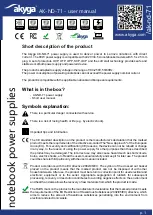
English |
7
(18)
Standard hole for base plate fastening
(19)
Hole for sawing close to edges
(20)
Guide for parallel guide
(21)
Locking screw for parallel guide
a)
(22)
Parallel guide with circle cutter
a)
(23)
Circle cutter centring tip
a)
a)
Accessories shown or described are not included with the
product as standard. You can find the complete selection of
accessories in our accessories range.
Technical Data
Jigsaw
GST 650
Article number
3 601 EA8 0..
Stroke rate preselection
●
Rated power input
W
450
Power output
W
225
No-load stroke rate n
0
min
−1
800–3100
Stroke
mm
18
Max. cutting depth
– in wood
mm
65
– in aluminium
mm
10
– in steel (unalloyed)
mm
3
Max. cutting angle (left/right)
°
45
Weight according to
EPTA‑Procedure 01:2014
kg
1.9
Protection class
/II
The specifications apply to a rated voltage [U] of 230 V. These spe-
cifications may vary at different voltages and in country-specific mod-
els.
Noise/Vibration Information
Noise emission values determined according to
EN 62841‑2‑11
.
Typically, the A-weighted noise level of the power tool is:
Sound pressure level
85
dB(A); sound power level
96
dB(A). Uncertainty K =
5
dB.
Wear hearing protection!
Vibration total values a
h
(triax vector sum) and uncertainty K
determined according to
EN 62841‑2‑11
:
Cutting boards with saw blade
T 111 C
:
a
h,B
=
4.5
m/s
2
, K =
1.5
m/s
2
,
cutting sheet metal with saw blade
T 118 A
:
a
h,M
=
5
m/s
2
, K =
1.5
m/s
2
.
The vibration level and noise emission value given in these
instructions have been measured in accordance with a
standardised measuring procedure and may be used to com-
pare power tools. They may also be used for a preliminary
estimation of vibration and noise emissions.
The stated vibration level and noise emission value repres-
ent the main applications of the power tool. However, if the
power tool is used for other applications, with different ap-
plication tools or is poorly maintained, the vibration level
and noise emission value may differ. This may significantly
increase the vibration and noise emissions over the total
working period.
To estimate vibration and noise emissions accurately, the
times when the tool is switched off or when it is running but
not actually being used should also be taken into account.
This may significantly reduce vibration and noise emissions
over the total working period.
Implement additional safety measures to protect the oper-
ator from the effects of vibration, such as servicing the
power tool and application tools, keeping their hands warm,
and organising workflows correctly.
Assembly
u
Pull the plug out of the socket before carrying out any
work on the power tool.
Inserting/changing the saw blade
u
When fitting or changing the saw blade, wear protect-
ive gloves.
Blades are sharp and can become hot when
used for prolonged periods of time.
Selecting the saw blade
You will find an overview of recommended saw blades at the
end of these operating instructions. Only use saw blades
with a single lug shank (T shank) or with a 1/4" universal
shank (U shank). The saw blade should not be longer than
required for the intended cut.
Use a narrow saw blade when sawing tight curves.
Inserting the saw blade (see figure A)
u
Clean the shaft on the saw blade before inserting it.
A dirty shaft cannot be securely fixed in place.
Loosen the saw blade fastening screw
(6)
using the hex
key
(4)
provided.
Push the saw blade
(8)
, with the teeth in the cutting direc-
tion, into the saw blade receptacle
(10)
➊
until it clicks into
place.
Make sure when inserting the saw blade that the back of the
saw blade is in the groove on the guide roller
(7)
.
Firmly tighten the screw
(6)
with the hex key
(4)
➋
.
u
Check that the saw blade is seated securely.
A loose
saw blade can fall out and lead to injuries.
Removing the saw blade (see figure B)
Unscrew the saw blade fastening screw
(6)
➊
and remove
the saw blade
(8)
➋
.
Anti-splinter guard (accessory) (see figure C)
The anti-splinter guard
(12)
(accessory) can prevent splin-
tering of the surface while sawing wood. The anti-splinter
guard can only be used with certain saw blade types and only
at a cutting angle of 0°. When sawing with the anti-splinter
guard, the base plate
(5)
must not be moved to the rear for
sawing close to edges.
Push the anti-splinter guard
(12)
into the base plate
(5)
from below.
Bosch Power Tools
1 609 92A 405 | (09.08.2021)








































